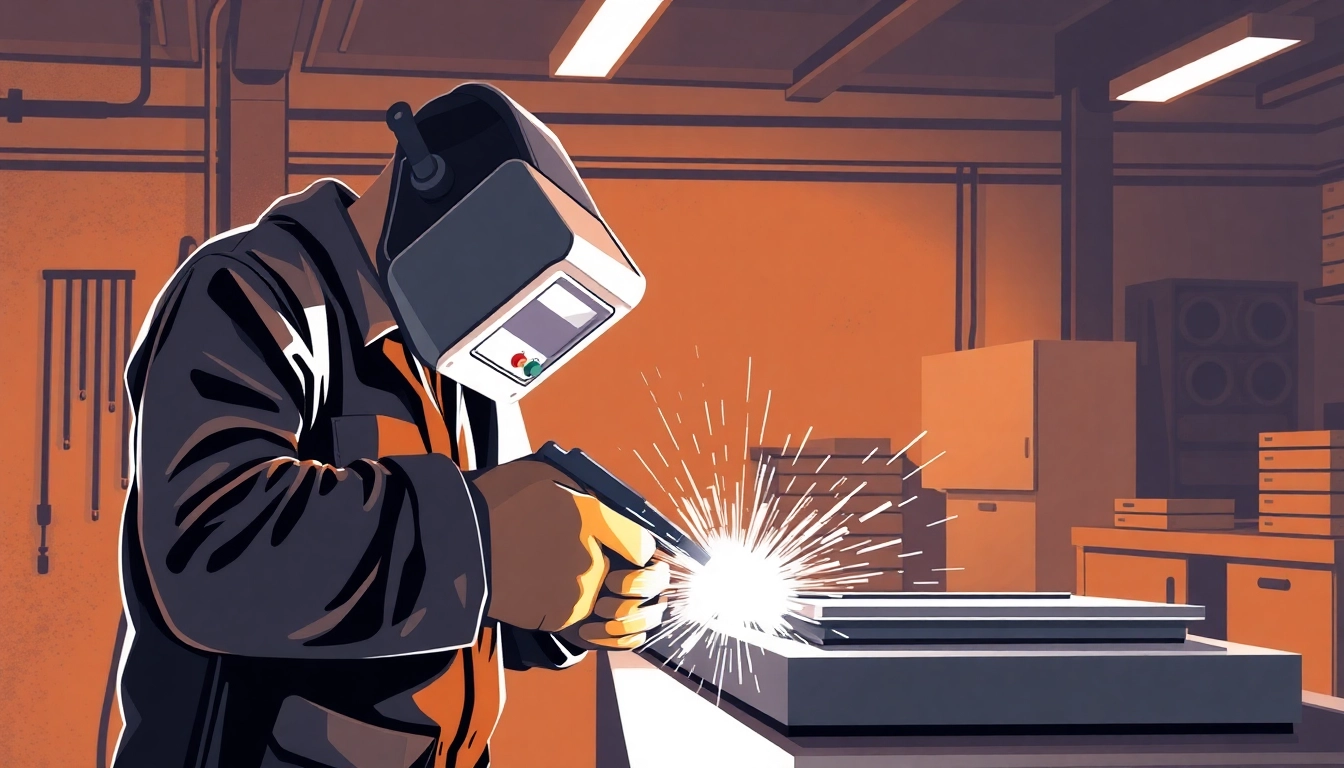Understanding AC DC TIG Welders
What is an AC DC TIG Welder?
An AC DC TIG welder is a highly versatile welding machine designed for Tungsten Inert Gas (TIG) welding. Unlike traditional welders that can operate solely on either alternating current (AC) or direct current (DC), AC DC TIG welders provide the flexibility to switch between the two. This capability allows for greater control and precision when welding different types of metals.
Alternating current is primarily used for welding aluminum and magnesium due to its ability to break through the oxide layer on these metals. In contrast, direct current is more effective for steel and stainless steel as it provides a stable and concentrated arc. By integrating both functions, an AC DC TIG welder becomes an essential tool for both amateur and professional welders alike.
Advantages of Using AC DC TIG Welders
- Versatility: AC DC TIG welders can handle a wide range of materials, including aluminum, stainless steel, and mild steel.
- Precision: TIG welding provides cleaner and more precise welds compared to other types of welding, making it ideal for intricate fabrications.
- Less Heat Affected Zone: The focused arc minimizes the heat input, reducing distortion and making it suitable for thin materials.
- Control: With features like adjustable amperage and variable frequency, welders can easily customize settings to suit specific tasks.
- Low spatter: TIG welding produces minimal spatter, which leads to cleaner joints and reduced post-weld cleanup.
Applications of AC DC TIG Welding
AC DC TIG welding is widely used across various industries due to its flexibility and precision. Here are some common applications:
- Aerospace: Used for critical components where strength and precision are vital.
- Automotive: Ideal for welding aluminum parts in high-performance vehicles.
- Manufacturing: Employed for fabricating high-quality machinery parts.
- Artistic Welding: Preferred by artists and craftsmen for creating intricate metal sculptures and designs.
- Construction: Effective for welding structural steel and specialized builds.
Choosing the Right AC DC TIG Welder
Key Features to Look For
When selecting an AC DC TIG welder, several features should be considered:
- Power Output: Look for models with adjustable amperage to accommodate various thicknesses of materials.
- AC Frequency Control: This allows precision when working with aluminum, helping to break the oxide layer for cleaner welds.
- Duty Cycle: A higher duty cycle means the welder can operate longer without overheating, which is crucial for extended tasks.
- Portability: Depending on your workspace, choose a welder that is lightweight and easy to move.
- User-Friendliness: Look for features such as an intuitive digital display and easy-to-understand controls.
Comparing Brands and Models
Not all AC DC TIG welders are created equal. Here are a few leading brands to consider:
- Miller: Known for their reliability and performance, Miller offers models like the Miller Dynasty series.
- Lincoln Electric: Their Aspect series is popular for control and efficiency.
- Everlast: Providing cost-effective, high-performance options for welders at all skill levels.
- PrimeWeld: Offers robust features at competitive prices, making them a great choice for both beginner and seasoned welders.
- Weldpro: Known for budget-friendly options that do not compromise on quality.
Price Range and Budget Considerations
The cost of AC DC TIG welders can vary significantly based on features and brand. Here is a breakdown:
- Entry-Level Models: Expect to pay between $500 and $1,000. These welders are suitable for hobbyists and light-duty tasks.
- Mid-Range Welders: Priced between $1,000 and $2,500, these machines often come with advanced features beneficial for more complex projects.
- Professional-Grade Welders: For heavy-duty applications, models can range from $2,500 to over $10,000, offering top-tier performance and durability.
Setting Up Your AC DC TIG Welder
Installation Tips for Optimal Performance
Proper installation is crucial for achieving the best results. Follow these steps:
- Read the Manual: Before installation, familiarize yourself with the specifications and safety recommendations outlined in the user manual.
- Position the Welder: Locate the welder in a well-ventilated area away from flammable materials.
- Connect the Gas Supply: Ensure that the argon gas supply is securely connected to the welder and check for leaks.
- Install Electrode Holder: Attach the electrode holder to the positive terminal for DC welding.
- Ground Clamp Connection: Use a quality grounding clamp connected to the workpiece for safety and better welding quality.
Necessary Accessories for TIG Welding
To make the most of your AC DC TIG welder, consider acquiring the following accessories:
- Gas Cylinder: A full argon cylinder is essential for the TIG process.
- Tungsten Electrodes: Select tungsten electrodes suitable for the materials being welded (e.g., 2% Lanthanated for aluminum).
- Filler Rods: Choose compatible filler rods for the metals you will be joining.
- Welding Gloves: High-quality gloves protect your hands from heat and sparks.
- Welding Helmet: An auto-darkening welding helmet enhances safety and visibility during welding.
- Flame Resistant Clothing: Wear appropriate clothing to protect against sparks and heat.
Safety Precautions While Welding
Welding involves risks, so adherence to safety best practices is essential. Here are some precautions:
- Protective Gear: Always wear appropriate protective gear including gloves, helmets, and flame-resistant clothing.
- Ventilation: Ensure proper ventilation for the work area to avoid inhaling harmful fumes.
- Fire Safety: Keep a fire extinguisher nearby and be aware of your surroundings during the welding process.
- Electrical Safety: Ensure that connections are secure and be cautious of the power supply when working with the welder.
Techniques for Using AC DC TIG Welders
Basic TIG Welding Techniques
Developing basic skills is essential for effective welding. Here are fundamental techniques:
- Stick Out Length: Control the distance between the tungsten tip and the workpiece to maintain a consistent arc.
- Travel Speed: Maintain a consistent speed to ensure even heat distribution and avoid burn-through.
- Angle of the Torch: Keep the torch at an angle of 15 to 20 degrees towards the direction of travel for better control.
- Filler Material Addition: Introduce filler material into the weld pool without contaminating the tungsten.
Advanced Techniques for Professional Results
For more seasoned welders, advanced techniques can enhance the quality of your work:
- Pulsed TIG Welding: This technique uses an alternating high and low current to improve control and reduce heat input.
- Weaving Patterns: Weaving may be employed to fill wider seams, ensuring even delivery of heat and filler material.
- Staggered Travel: Change direction of travel to improve fusion on thicker materials or large gaps.
- Techniques for Distortion Control: Understanding how to strategically plan weld placements can minimize distortion in the final product.
Troubleshooting Common Issues
Even seasoned welders may encounter problems. Here are common issues and their fixes:
- Inconsistent Arc: Check your ground connection and ensure that the tungsten is properly sharpened and the correct size for the material.
- Excessive Spatter: Adjust the amperage and ensure that the filler rod is compatible and clean.
- Poor Penetration: Increase travel speed or amperage as needed, or consider the condition and type of material being welded.
- Contaminated Welds: Inspect your tungsten and filler rods for impurities and ensure a clean work surface before welding.
Maintenance and Care for Your AC DC TIG Welder
Routine Maintenance Practices
Maintaining your AC DC TIG welder is essential for longevity and peak performance. Here are routine practices:
- Cleaning: Regularly clean the welder exterior and check for signs of wear or damage.
- Tungsten Replacement: Replace tungsten electrodes when worn or contaminated to ensure optimal performance.
- Gas Flow Checks: Ensure gas lines are free from leaks and the flow rate is within proper specifications.
- Inspect Cables: Regularly check power and ground cables for frays or damage.
Understanding Warranty and Support
Investing in a reliable brand often comes with warranty protections. Understand your options:
- Manufacturer’s Warranty: Most models come with a warranty that covers defects—make sure to read the specifics.
- Customer Support: Opt for brands with robust customer service and support networks for troubleshooting and repairs.
Upgrading Your Equipment
As your skills develop or your projects become more demanding, upgrading your equipment may become necessary. Consider the following:
- Feature Upgrades: Consider welders with advanced features like multi-channel outputs or built-in digital displays.
- Power Upgrades: If you regularly work with thicker materials, look for models offering higher amps and better duty cycles.
- Accessory Integration: Invest in additional accessories that could enhance your welding versatility and efficiency.




